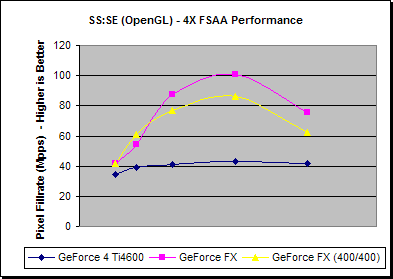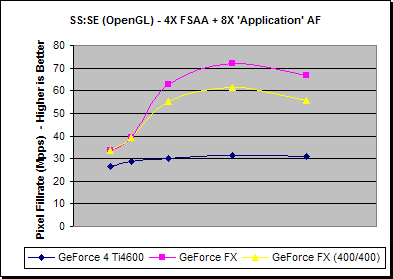FSAA Performance Comparison
Again, using the SS:SE test we'll take a performance comparison of the boards under 4X FSAA to see how effective GeForce FX's colour compression routines are in relation to GeForce 4's performance.

| 4X FSAA | 640x480 | 800x600 | 1024x768 | 1280x1024 | 1600x1200 |
| GeForce 4 Ti4600 | 113.2 | 81.4 | 52.5 | 32.8 | 21.9 |
| GeForce FX | 135.6 | 113.6 | 111.7 | 77.1 | 39.3 |
| GeForce FX (400/400) | 135.5 | 127.0 | 98.1 | 65.7 | 32.4 |
| % Diff from Ti4600 | 640x480 | 800x600 | 1024x768 | 1280x1024 | 1600x1200 |
| GeForce FX | 20% | 40% | 113% | 135% | 79% |
| GeForce FX (400/400) | 20% | 56% | 87% | 100% | 48% |
Comparing the different boards with 4X FSAA we can see that the GeForce4 Ti, which has no colour compression abilities, just Z compression, becomes bandwidth limited very quickly. GeForce FX, on the other hand, has plenty of performance left in it, due to its higher bandwidth and compression routines. We can see that at best, the 5800 Ultra is in excess of twice as fast as the GeForce4 with 4X FSAA enabled, and even running at 400/400 it is still twice as fast.
We can also see that again the 5800 running at 400/400 performs a little higher than the 5800 at 500/500 in the low resolutions.

| 4XFSAA + 8X AF | 640x480 | 800x600 | 1024x768 | 1280x1024 | 1600x1200 |
| GeForce 4 Ti4600 | 86.1 | 59.4 | 38 | 23.8 | 16.1 |
| GeForce FX | 109.8 | 82.1 | 79.9 | 55.1 | 34.8 |
| GeForce FX (400/400) | 110 | 81.6 | 70.1 | 46.8 | 29.0 |
| % Diff from Ti4600 | 640x480 | 800x600 | 1024x768 | 1280x1024 | 1600x1200 |
| GeForce FX | 28% | 38% | 110% | 132% | 116% |
| GeForce FX (400/400) | 28% | 37% | 84% | 97% | 80% |
Utilising the highest texturing modes available to all boards, which is the 8x ‘Application’ AF for GeForce FX, in conjunction with 4X FSAA we can see that the relative performance differences between the boards are pretty much in line with those of just 4X FSAA rendering.
